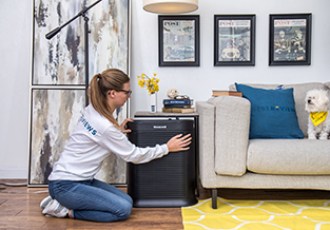We recommend these products based on an intensive research process that's designed to cut through the noise and find the top products in this space. Guided by experts, we spend hours looking into the factors that matter, to bring you these selections.

In warm weather, a quality fan can circulate the air in your home so your environment doesn’t feel so warm and stuffy. If you’re looking to conserve space, a wall fan may be the perfect solution.
Unlike a ceiling fan, the blades of a wall fan aren’t exposed. Instead, they’re enclosed in a casing for safer operation. Typically placed at eye level for ease of use, wall fans are quite easy to install. Many are also adjustable, allowing you to direct the airflow precisely where you want it.
When choosing a wall fan, you’ll need to decide which size is right for your home. Motor power and blade configuration are also important considerations.

Where will you install your wall fan? It could work in practically any room with limited space, but certain areas may be more prone to stuffiness, such as a basement, home gym, kitchen, or child’s playroom.
Some homeowners also install wall fans in areas outside the home, such as a garage, shed, or greenhouse. In fact, it’s not unheard of to install a wall fan on an outdoor patio for use on particularly hot days.
Once you’ve decided where to install the fan, measure the space. This will give you a better idea of what size fan you need for effective circulation. To figure out how many cubic feet per minute (CFM) you need the fan to move, here’s what to do.
Blade size affects how well a wall fan moves air in a room. In a small space, 12-inch blades are usually sufficient. In a medium to large space, you’d want a fan that has 16- to 30-inch blades.
As with any fan, it’s a good idea to choose one with multiple speeds. That allows you to select a speed that’s powerful enough to effectively circulate the air in your room but not so fast that it blows things around or makes too much noise. Some wall fans offer just two speeds while others offer up to three.
It’s usually best to choose a larger fan that you can run at a low or medium speed to move the air around your room. Lower speeds typically don’t make as much noise as higher speeds.
Many wall fans have an adjustable head that allows you to direct the airflow from the fan. Because most wall fans are installed at eye or head level, it should be fairly easy to reach up and tilt the fan head.
Wall fans often have an oscillation feature that moves the head back and forth. This helps move the air over a wider area. It’s nice to have options, though. We tend to support wall fans with an oscillation feature that can be turned on and off at will.
Some wall fans have built-in timers. This allows you to turn off the fan at your chosen time. For example, you might set a timer so the fan moves air around your bedroom while you’re drifting off and then turns off after you fall asleep.
Some wall fans come with a remote control for convenience. A remote allows you to turn the fan on and off and adjust speeds even when you’re across the room, so you don’t need to get up.
Wall fans come in neutral colors like black, white, beige, gray, and silver. As such, you should have an easy time finding an option to suit your color scheme.

Inexpensive: Wall fans that cost between $34 and $120 are usually small models with 12- to 16-inch blades and a lower CFM, so they work best for small rooms. They’re often adjustable and may offer an oscillating feature.
Mid-range: Wall fans priced between $120 and $310 usually have blades that measure 16 to 18 inches as well as a higher CFM. They work well in medium to large rooms and often feature an adjustable head, an oscillating feature, and a remote control.
Expensive: The priciest wall fans are large home or industrial models that cost between $310 and $730. Their blades are at least 18 inches long, though some have blades as long as 30 inches. For the money, you should expect an adjustable head, an oscillating feature, and a remote control.

Q. Are wall fans loud?
A. Like many fans, wall fans can be somewhat noisy, particularly when running at the highest speed. To keep noise down, consider selecting a larger wall fan that you can run on low or medium speed. A smaller fan that you must run on high can make a lot more noise.
Q. What’s the difference between home wall fans and industrial wall fans?
A. Industrial wall fans are generally larger because they’re designed to circulate air through a wider area. However, you can find some home wall fans that are fairly large. Residential models are also usually lighter in weight and easier to install.
Q. Is wall fan installation a good DIY project?
A. Most wall fans offer a pretty straightforward installation, so a fair portion of consumers feel confident handling the task. Most manufacturers provide clear instructions for installation and include the brackets and other hardware you need to mount the fan.
Get emails you’ll love.
Learn about the products you’re wondering if you should buy and get advice on using your latest purchases.
